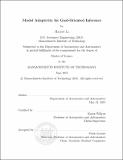| dc.contributor.advisor | Karen Willcox. | en_US |
| dc.contributor.author | Li, Harriet | en_US |
| dc.contributor.other | Massachusetts Institute of Technology. Department of Aeronautics and Astronautics. | en_US |
| dc.date.accessioned | 2016-03-03T20:28:42Z | |
| dc.date.available | 2016-03-03T20:28:42Z | |
| dc.date.copyright | 2015 | en_US |
| dc.date.issued | 2015 | en_US |
| dc.identifier.uri | http://hdl.handle.net/1721.1/101440 | |
| dc.description | Thesis: S.M., Massachusetts Institute of Technology, Department of Aeronautics and Astronautics, 2015. | en_US |
| dc.description | Cataloged from student-submitted PDF version of thesis. | en_US |
| dc.description | Includes bibliographical references (pages 47-49). | en_US |
| dc.description | This electronic version was submitted by the student author. The certified thesis is available in the Institute Archives and Special Collections. | en_US |
| dc.description.abstract | In scientific and engineering contexts, physical systems are represented by mathematical models, characterized by a set of parameters. The inverse problem arises when the parameters are unknown and one tries to infer these parameters based on observations. Solving the inverse problem can require many model simulations, which may be expensive for complex models; multiple models of varying fidelity and complexity may be available to describe the physical system. However, inferring the parameters may only be an intermediate step, and what is ultimately desired may be a low-dimensional Quantity of Interest (QoI); we refer to this as the goal-oriented inverse problem. We present a novel algorithm for solving the goal-oriented inverse problem, which allows one to manage the fidelity of modeling choices while solving the inverse problem. We formulate a hierarchy of models, and assume that the QoI obtained by inferring the parameters with the highest-fidelity model is the most accurate QoI. We derive an estimate for the error in the QoI from inferring the parameters using a lower-fidelity model instead of the highest-fidelity model. This estimate can be localized to individual elements of a discretized domain, and this element-wise decomposition can then be used to adaptively form mixed-fidelity models. These mixed-fidelity models can be used to infer the parameters, while controlling the error in the QoI. We demonstrate the method with two pairs of steady-state models in 2D. In one pair, the models differ in the physics included; in the other pair, the models differ in the space to which the parameters belong. In both cases, we are able to obtain a QoI estimate with a small relative error without having to solve the inverse problem with the high-fidelity model. We also demonstrate a case where solving the inverse problem with the high-fidelity model requires a more complex algorithm, but where our method gives a mixed-fidelity model with which we can infer parameters using a simple Newton solver, while achieving a low error in the QoI. | en_US |
| dc.description.statementofresponsibility | by Harriet Li. | en_US |
| dc.format.extent | 49 pages | en_US |
| dc.language.iso | eng | en_US |
| dc.publisher | Massachusetts Institute of Technology | en_US |
| dc.rights | M.I.T. theses are protected by copyright. They may be viewed from this source for any purpose, but reproduction or distribution in any format is prohibited without written permission. See provided URL for inquiries about permission. | en_US |
| dc.rights.uri | http://dspace.mit.edu/handle/1721.1/7582 | en_US |
| dc.subject | Aeronautics and Astronautics. | en_US |
| dc.title | Model adaptivity for goal-oriented inference | en_US |
| dc.type | Thesis | en_US |
| dc.description.degree | S.M. | en_US |
| dc.contributor.department | Massachusetts Institute of Technology. Department of Aeronautics and Astronautics | |
| dc.identifier.oclc | 934637325 | en_US |

